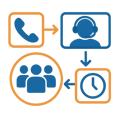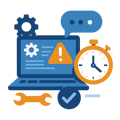Call Routing & Call Tracking

boberdoo’s Advanced Call Routing Software
Explore boberdoo
boberdoo's advanced lead and call routing technology has been assisting lead generation companies, advanced affiliates, media companies and more since 2001. Our system is built to fully automate all of your back-office tasks, saving you countless hours and even presenting you with new opportunities to generate revenue. As a leader in the industry, our technology is constantly pushing the boundaries for lead businesses. If you're looking for a tried and true system built to scale, you can do no better than boberdoo.
What Are Call Routing And Call Tracking?

- 01 Call Routing
- 02 Call Tracking
Call Routing
Call Tracking
The Role Of Call Routing And Call Tracking In Lead Generation
How To Plan A Successful Call Routing Strategy/Campaign
Planning a successful call routing strategy requires careful consideration of your business objectives, technical requirements and customer needs. Here's a step-by-step plan to get you started.
Document every potential path a caller might take through your system. Consider various scenarios: a new customer calling about services, an existing client with support needs or emergency service requests. This mapping helps identify where automated routing can streamline the process and where human interaction is most valuable.
Create clear and specific criteria for directing calls. Consider factors such as:
• Geographic location of callers and service providers
• Time zones and business hours
• Service type and urgency
• Required skill sets or certifications
• Current capacity and availability of recipients
If implementing an Interactive Voice Response (IVR) system, focus on creating clear, concise menu options that guide callers efficiently to their destination. Keep menus shallow and logical, avoiding complex hierarchies that frustrate callers. Test different menu structures to find the most intuitive arrangement for your specific audience.
Before full deployment, thoroughly test your routing system under various scenarios. Conduct pilot programs with smaller call volumes to identify and address any issues. Regularly reviewing and refining your routing rules ensures the system meets your business objectives while maintaining high customer satisfaction.
Systematically planning your call routing strategy creates a foundation for efficient operations and positive customer experiences. Successful implementation often requires ongoing optimization based on real-world performance data and changing business needs.
Call Routing Benefits For Sellers
Traditional call distribution often settles for acceptable revenue rather than optimal revenue. Simple highest-bid routing overlooks performance factors that impact actual value realization. In contrast, sequential routing restricts buyer participation and competitive dynamics. You may think you're maximizing revenue, but you're leaving significant money on the table with every call.
boberdoo's revenue-per-call optimization evaluates every call distribution decision based on predicted outcomes rather than simple bid amounts. The Earnings-Per-Lead algorithm considers buyer conversion rates, average transaction values, callback patterns, and long-term relationship factors to identify the buyer most likely to generate maximum revenue from each specific call.
Performance prediction models utilize historical data to calculate the expected value for each potential buyer, rather than relying solely on their bid amounts. A buyer who bids $25 but converts 80% of calls might represent better value than a buyer who bids $30 but converts only 50% of calls. Revenue optimization considers actual expected value rather than nominal pricing.
Call characteristic analysis matches caller profiles with buyer strengths to optimize conversion probability. Some buyers excel with high-value commercial calls, while others perform better with residential opportunities. Geographic specialization, project type expertise, and timing preferences all play a role in revenue optimization decisions.
Long-term value consideration weighs immediate revenue against the preservation of relationships and the development of future opportunities. Sometimes accepting a slightly lower immediate bid from a high-volume buyer generates more total revenue than maximizing single-call pricing with inconsistent buyers. Revenue optimization strikes a balance between short-term and long-term value creation.
Post-call learning enhances future revenue optimization, as actual outcomes provide valuable feedback on prediction accuracy. When buyers exceed or underperform expectations, the system updates performance models accordingly. Revenue optimization becomes more accurate over time through continuous learning from actual results.
Scale Calls and Save Money: Growth Without Platform Penalties
Traditional call routing platforms punish success by increasing costs as volume grows. Per-minute charges mean that higher volumes equal higher platform costs, creating artificial barriers to scaling profitable call operations. This backwards incentive structure makes growth expensive instead of rewarding success with better economics.
boberdoo's Twilio integration creates the opposite dynamic, where scale improves economics rather than penalizing growth. As your call volume increases, Twilio's volume discounts reduce your per-minute costs. At the same time, boberdoo's routing intelligence makes it so those calls generate maximum revenue. Scale becomes a competitive advantage rather than a cost burden.
Infrastructure scaling happens automatically without requiring capacity planning or performance degradation. Whether you're processing 1,000 calls per month or 100,000 calls per day, the system maintains consistent performance and reliability. Growth doesn't require infrastructure investment or performance compromises that limit your ability to capitalize on opportunities.
Operational efficiency improves with scale because unified systems handle increased complexity without proportional increases in management overhead. Adding new buyers, new verticals and new geographic markets doesn't require additional staff or operational complexity. Efficiency scales with volume rather than creating exponential overhead growth.
Cost structure optimization benefits from scale economies in software licensing, infrastructure costs, and operational overhead. Larger operations spread fixed costs across more transactions while benefiting from volume discounts and preferred provider relationships. Scale delivers better unit economics than penalty costs.
Competitive advantages emerge from scale when larger operations can offer better service levels, more comprehensive coverage, and superior technology that smaller competitors cannot match. Scale becomes a strategic moat rather than an operational burden when platform economics align with business success.
Advanced Reporting Suite: Make Data-Driven Decisions with Comprehensive Analytics
Call routing optimization requires sophisticated analytics that go beyond basic volume and revenue reporting. Understanding buyer performance patterns, caller behavior, market trends and optimization opportunities demands comprehensive data analysis across multiple dimensions and time periods.
boberdoo's advanced reporting suite provides detailed analytics that support sophisticated decision-making across all aspects of call routing operations. Real-time dashboards, historical trend analysis and predictive insights help optimize performance while identifying opportunities for growth and improvement.
Buyer performance analytics track detailed metrics for every buyer, including answer rates, conversion rates, average call duration, customer satisfaction indicators and long-term value generation. Instead of simple volume reports, you get actionable insights that guide buyer relationship management and routing optimization decisions.
Call quality analysis examines patterns in call outcomes, buyer feedback and customer satisfaction to identify optimization opportunities and quality issues. When specific call sources consistently generate poor outcomes or buyer complaints, quality analysis helps identify problems and implement solutions before they impact your reputation.
Revenue optimization reporting tracks the effectiveness of routing decisions and identifies opportunities for improved performance. Compare actual outcomes with predicted results to refine routing algorithms and optimize performance. Analyze revenue per call trends across different buyers, time periods and call characteristics to optimize future distribution decisions.
Market intelligence offers valuable insights into competitive dynamics, pricing trends and emerging opportunities, informing strategic decision-making. Understanding how your performance compares to market benchmarks enables strategic positioning, identifying growth opportunities and recognizing competitive threats.
Unified Budget Management: Coordinate Spending Across All Lead Types
Managing buyer relationships across separate systems for different lead types creates operational inefficiency while limiting revenue optimization opportunities. Buyers should increase call volume while reducing the number of leads purchased. However, separate systems prevent intelligent budget reallocation that maximizes buyer satisfaction and your revenue potential.
boberdoo's unified budget management coordinates buyer spending across calls, leads and clicks through intelligent algorithms that optimize allocation based on performance data and buyer preferences. Instead of managing separate budgets that can't adapt to changing conditions, you provide flexible budget management that maximizes buyer ROI and your revenue potential.
Dynamic budget allocation shifts spending between lead types based on performance patterns and availability. When call opportunities are limited due to time-of-day factors, buyer budgets automatically shift toward available lead opportunities. When high-performing call sources become available, budget reallocation ensures buyers can access quality opportunities as they arise.
Buyer preference learning adapts budget allocation based on buyer behavior and stated preferences. Buyers who consistently prefer calls over leads receive budget priority for call opportunities. Buyers whose business models favor specific lead types get allocation optimization that reflects their actual needs rather than arbitrary budget categories.
Performance-based allocation rewards buyers who convert well across multiple lead types while managing allocation for buyers whose performance varies by channel. Unified management enables sophisticated buyer relationship optimization that considers total performance rather than individual channel results.
Relationship value optimization considers factors beyond immediate transaction value when managing buyer budgets. Buyers who provide market intelligence, refer other valuable relationships or contribute to network effects might receive budget management flexibility that reflects their total contribution to business success.
Automated Buyer Onboarding: Scale Your Network Without Administrative Overhead
Buyer network expansion traditionally requires significant administrative overhead for each new relationship. Account setup, integration testing, performance baseline establishment, and relationship management create operational bottlenecks that limit network growth and prevent rapid response to market opportunities.
boberdoo's automated buyer onboarding reduces administrative overhead while accelerating new buyer integration. Standardized setup processes, automated testing protocols and systematic performance tracking enable rapid expansion of the buyer network without proportional increases in administrative workload.
Standardized integration protocols enable new buyers to connect quickly without custom technical work. Self-service onboarding portals guide buyers through account setup, payment method configuration and integration testing. Most buyers can complete onboarding independently without requiring support team involvement for routine setup tasks.
Automated testing allows new buyer integrations to function correctly before routing live calls. Test call protocols verify routing functionality, payment processing and feedback systems work correctly. Performance baseline establishment tracks initial buyer behavior to identify potential issues early while establishing benchmarks for ongoing relationship management.
Performance monitoring begins immediately when new buyers join your network, providing early indicators of relationship potential and identifying opportunities for optimization. Instead of waiting weeks or months to evaluate new buyer performance, automated monitoring provides rapid feedback that guides relationship development strategies.
Relationship development guidance suggests optimization strategies based on early performance data and buyer behavior patterns. When new buyers show potential but need guidance, automated systems suggest coaching opportunities, performance improvements or relationship adjustments that could enhance mutual success.
Call Routing Benefits For Buyers
Cost Control at Scale: Your Twilio Account, Your Savings
Traditional call routing platforms profit from your success by charging per-minute fees that increase as your volume grows. This creates perverse incentives where platform vendors benefit from longer calls and higher volumes regardless of whether those calls generate value for your business. Success becomes expensive instead of profitable.
boberdoo's Twilio integration eliminates these misaligned incentives by directly connecting to your Twilio account. You pay Twilio's wholesale rates for actual usage while boberdoo provides routing intelligence and platform functionality. As your volume scales, your per-minute costs decrease through Twilio's volume discounts, rather than increasing due to platform markups.
Transparent pricing means you see exactly what call routing costs without hidden fees or surprise charges. Twilio bills you directly for the minutes used at clearly published rates, which often decrease as volume increases. boberdoo charges for routing intelligence and platform functionality, not usage volume. This transparency enables accurate financial planning and ROI calculation.
Volume discount benefits accrue directly to your business rather than platform vendors. Twilio offers significant volume discounts to clients who use substantial monthly minutes. These savings flow directly to your bottom line, rather than being captured by platform vendors who mark up wholesale rates. Higher volume leads to better unit economics rather than higher platform costs.
Cash flow optimization improves when you control billing relationships directly. Instead of paying platform vendors who then pay carriers, you manage one relationship with Twilio for usage costs and one with boberdoo for platform functionality. This reduces payment delays and provides better visibility into actual costs versus platform markups.
Financial control extends to features and functionality where you can add Twilio services directly without platform vendor approval or markup. Need SMS capabilities? Add them through your Twilio account at cost. Want international routing? Activate it directly with Twilio pricing. Platform control belongs to you rather than vendor gatekeepers.
Unified Budget Management: Optimize Spending Across All Lead Types
Managing buyer budgets across separate systems for calls, leads and clicks creates operational complexity while limiting optimization opportunities. Buyers might exhaust their call budget while having unused lead budget, or vice versa. Separate systems prevent intelligent budget allocation that maximizes buyer satisfaction and your revenue potential.
boberdoo's unified budget management optimizes buyer spending across all lead types through intelligent allocation algorithms. When buyers have a budget available, the system determines whether calls, leads or clicks will provide the best ROI for their specific business model and current needs. Budget optimization occurs automatically, eliminating the need for constant manual adjustments.
Cross-channel budget optimization considers buyer performance across all lead types to allocate budget where it will generate the most value. A buyer who converts calls at higher rates than leads should receive more call allocation when possible. Buyers whose data leads convert better might receive budget priority for lead opportunities over calls. Intelligence drives allocation rather than arbitrary budget silos.
Real-time budget reallocation responds to changing conditions and performance patterns without manual intervention. When call opportunities decrease due to time-of-day factors, buyer budgets automatically shift toward lead opportunities. When high-performing call sources become available, budget reallocation provides access to quality opportunities as they arise.
Buyer relationship optimization improves when budget management considers total relationship value rather than individual transaction types. Buyers who consistently provide volume across multiple lead types may receive budget flexibility, providing access to quality opportunities even when specific budgets are low. Relationship value drives budget decisions rather than rigid category limits.
Performance-based budget allocation rewards buyers who convert well, while reducing allocation for those who do not. Budget allocation becomes a performance management tool that incentivizes buyer success while protecting your inventory from buyers who waste opportunities. Good performance earns more opportunities, while poor performance results in a reduced allocation.
Smart Agent Distribution: Route Calls to Agents Who Convert
Traditional call routing often ignores agent-level performance differences within buyer organizations. A call might reach the right company but get routed to an agent who consistently provides poor service or fails to convert opportunities. Agent-level routing intelligence can dramatically improve conversion rates and customer satisfaction.
boberdoo's smart agent distribution tracks performance at the individual agent level when buyers provide agent-specific phone numbers or extension routing. The system learns which agents convert calls most effectively and routes accordingly, improving both buyer success and caller satisfaction through better matching.
Agent performance analytics consider multiple factors beyond simple conversion rates, including call duration, callback rates, customer satisfaction indicators and long-term customer value. Some agents have lower immediate conversion rates but generate higher lifetime customer values through better relationship building. Smart distribution takes into account these nuanced performance factors.
Load balancing pushes a fair distribution among high-performing agents, while avoiding overload situations that could degrade service quality. Instead of always routing to the single best performer, the system distributes calls among top performers to maintain service levels while providing development opportunities for improving agents.
Training opportunity identification suggests which agents might benefit from additional coaching or development based on performance patterns and conversion analytics. When agents show potential but need improvement, smart distribution can provide an appropriate call mix that supports development while maintaining overall performance standards.
Buyer coaching insights help improve overall agent performance by identifying best practices and common issues across agent networks. When specific agents consistently outperform others, analysis reveals techniques and approaches that can be shared with other agents to improve overall buyer performance.
Real-Time Performance Intelligence: See What Actually Drives Results
Call routing decision-making requires real-time intelligence about buyer performance, market conditions and quality indicators. Traditional systems provide basic reporting that lags behind current conditions, forcing you to make routing decisions based on outdated information while market conditions change rapidly.
boberdoo's real-time performance intelligence updates continuously to provide current insights into buyer performance, market dynamics and optimization opportunities. Instead of waiting for daily or weekly reports, you see performance indicators update as calls complete, enabling immediate responses to changing conditions.
Conversion tracking occurs in real-time as buyers report call outcomes through automated systems or manually update disposition statuses. When buyer conversion rates suddenly improve or decline, routing algorithms adjust immediately rather than waiting for batch processing or manual analysis. Performance changes affect routing decisions within minutes rather than days.
Quality indicators provide immediate feedback about call quality, buyer responsiveness and customer satisfaction. When buyers consistently fail to answer calls, provide poor service or generate customer complaints, performance intelligence updates routing priorities accordingly. Quality protection happens proactively rather than reactively.
Market condition monitoring reveals trends and patterns that affect routing optimization across your entire call network. When specific verticals exhibit increased demand, geographic areas experience seasonal fluctuations or competitive dynamics alter pricing patterns, intelligence systems adjust routing strategies to capitalize on opportunities or mitigate problems.
Predictive performance modeling uses current data to anticipate future performance patterns and recommend proactive routing adjustments. When performance indicators suggest declining buyer quality or emerging opportunities, predictive intelligence enables strategic responses before trends become obvious to competitors.
Custom IVR Builder: Qualify Calls Before Distribution
Interactive Voice Response (IVR) systems can dramatically improve call quality and conversion rates by collecting qualification information before routing calls to buyers. However, most IVR systems require technical expertise to build and modify, making it difficult to adapt to changing requirements or optimization opportunities.
boberdoo's custom IVR builder enables non-technical users to create sophisticated call qualification flows that improve lead quality while reducing buyer costs. Visual workflow designers make it easy to build complex qualification logic without requiring programming expertise or technical support for modifications.
Call qualification workflows collect information that enables better buyer matching and higher conversion rates. Geographic qualification makes sure calls reach buyers who serve specific areas. Project type qualification routes calls to buyers who specialize in relevant services. Budget qualification connects calls with buyers who can meet customer requirements.
Dynamic scripting adapts IVR content based on caller responses and routing logic. Instead of static scripts that provide the same information regardless of the caller's needs, dynamic systems present relevant information and collect appropriate qualification data based on the caller's responses and intended routing destinations.
Multi-language support enables effective communication with diverse caller populations, eliminating the need for separate IVR systems for different languages. Automatic language detection and routing provide appropriate language options, enabling effective buyer matching by collecting qualification information.
Performance optimization tracks IVR effectiveness and identifies opportunities for improvement based on caller behavior and conversion outcomes. When specific qualification questions prove ineffective or cause caller abandonment, performance data guides IVR optimization, which improves both the caller experience and buyer outcomes.
Why Choosing The Right Call Routing Solution Matters
Your call routing solution must grow with your business. As call volumes increase and business requirements evolve, your system should seamlessly accommodate these changes without requiring significant infrastructure overhauls. The right platform allows you to adjust routing rules, add new phone numbers and modify call flows without disrupting operations.
Modern businesses rely on multiple systems working in harmony. Your call routing solution should integrate smoothly with your existing technology stack, including CRM systems, payment processing platforms and analytics tools. Make sure the system you select can play nice with all the other integrations you use for consistent data flow across your organization. This will also provide a complete view of customer interactions.
Effective call routing isn't just about connecting calls and maintaining service quality. The right solution provides monitoring capabilities, including call recording, quality scoring and performance analytics. These features help identify training opportunities, optimize routing rules, and ensure consistent service delivery across all customer touchpoints. The best solutions also consider the future and regulations, such as the FCC one-to-one consent ruling for calls.
Every business has unique requirements for handling calls. Your solution should offer customization options that address your specific needs, whether it's sophisticated IVR menus, complex routing rules based on multiple criteria or specialized reporting capabilities. Having a flexible call routing system supports rather than constrains your operations.
Price tags for call routing platforms can seem high, especially when lumped in with all other business expenses, but consider the long-term return on investment. The right solution helps optimize operational efficiency, improve conversion rates and reduce manual handling costs. It should provide clear metrics to track these improvements and justify the investment through measurable business outcomes.
Technical support and system reliability are important not only for onboarding and troubleshooting issues but also for determining if outages occur and how they handle them. Your chosen solution should offer sensible support options and maintain high system availability. Consider factors like uptime guarantees, support response times and the provider's track record in maintaining service quality.

Future-proofing technology and business needs evolve rapidly. Choose a solution that regularly updates its features and capabilities to incorporate new technologies and best practices. Your call routing system will continue growing and adapting to market conditions and customer expectations.
By carefully evaluating these factors, you can select a call routing solution that meets your current needs and positions your business for future success. Remember that the right solution becomes a strategic asset, enabling efficient operations while providing the insights needed for continuous improvement and growth.
Looking To Update Your Call Routing Operations?
Before going further, if you're looking to enter the call routing space or have already operated it, surprise! boberdoo is the premier call routing solution. It empowers you to implement sophisticated IVR systems, manage multiple conversion pathways and optimize your lead generation process, helping you quickly achieve your business goals. The boberdoo platform offers the flexibility and scalability to handle complex routing scenarios while maintaining efficient operations and transparent performance metrics.
Or contact our team at 800-776-5646 for a personalized consultation
Real World Examples
- 01 Converting Data Leads to Premium Live Transfers
- 02 Advanced IVR Management
- 03 Dual-Path Conversion
- 04 Real-Time Call Qualification
Converting Data Leads to Premium Live Transfers
Did you know companies can transform purchased data leads into high-value live transfers in the health insurance industry? Say this company buys data leads through ping-post bidding; its internal team qualifies them through a thorough vetting process. Once qualified, the leads are sent the number in different ways such as emails, direct mail, put into retargeting campaigns or other ways, then when they call are converted into live transfers and sold to premium buyers at significantly higher rates. This model allows the company to take on the conversion risk while maintaining healthy profit margins through efficient qualification processes. The system's comprehensive tracking ensures profitable operations by monitoring conversion rates, qualification metrics, and vendor performance.

Advanced IVR Management
Dual-Path Conversion
Real-Time Call Qualification
An Overview Of boberdoo's Call Routing Solutions
IVR capabilities let businesses gather additional information and add logic for routing calls. boberdoo's IVR systems can be tailored to specific business requirements, improving call flow efficiency and customer experience while collecting valuable data for routing decisions.
Advanced Features of boberdoo's Call Routing System

boberdoo's sophisticated queue management system enables real-time monitoring and adjustment of call flows. The system automatically manages concurrent call limits, preventing any single buyer or contractor from becoming overwhelmed while ensuring optimal call distribution. When a recipient reaches their maximum capacity, calls are automatically routed to the next qualified buyer, maintaining efficient service delivery.

The platform's advanced filtering capabilities allow businesses to create detailed routing rules based on multiple parameters. Companies can filter calls based on geographic location, time zones, service types, and custom-defined criteria. These filter sets integrate seamlessly with existing lead distribution rules, ensuring consistent lead management across all channels.

boberdoo provides robust call recording and monitoring capabilities for quality assurance and training. The system maintains detailed records of all calls, including duration, outcome, and routing path. This data feeds into comprehensive analytics tools that help businesses optimize their routing strategies and improve conversion rates.

boberdoo includes sophisticated handling for after-hours and emergencies. The system can automatically adjust routing rules based on time of day, service urgency and contractor availability. The system maintains efficiency during standard business hours, ensuring high-priority and emergency calls receive immediate attention.

The platform excels at managing multiple campaigns simultaneously. Each campaign can have its own unique routing rules, IVR flows and reporting requirements. This flexibility allows businesses to run specialized campaigns while maintaining centralized control and monitoring.

boberdoo's API capabilities enable deep integration with external systems and custom applications. Companies can create customized solutions utilizing the platform's robust routing and tracking features. The API supports real-time data exchange, enabling sophisticated automation and customization options.


